Our view at Stack - Simplify growth with an all-in-one platform. Powerful marketing, sales, and support automation. Integrated CMS. Scalable software. Crafted for customer experience.
Part of the reason I went into marketing is because I love creating. It’s also why the topic of the best AI for images intrigues me.
I love writing (surprise), cooking, design, and photography. I also used to paint and sew. But thanks to artificial intelligence (AI), you no longer have to be a lifelong creative to turn an idea into a visual reality.

AI image generators help anyone create visuals that are weird, wonderful, and … weirdly wonderful. (Remember the Willy Wonka debacle in Glasgow?)
But how exactly do they work and what’s the best AI image generator for marketers? I tested the top options for you. Here’s the scoop.
Table of Contents
- How do AI image generators work?
- How I Tested the Best AI for Images
- The Best AI Image Generators
How do AI image generators work?
Plagiarism is a big concern with even the best AI image generators. And it makes sense considering the very nature of how they work. AI image generators create by reimagining things that already exist. They don’t copy. They borrow and recycle.
How It Works:
- The AI is “trained” on millions of existing images, descriptions, and captions available across the internet. This is how it “learns” what things look like and what they are called.
- When you enter a prompt into a tool, the AI reaches into its memory of those images and captions.
- The AI produces an image or selection of images it believes fit your prompt.
Think of it like a contemporary singer sampling a song from a bygone era. They’ve made it their own, but pieces of the original are still there and recognizable.
(Author’s note: Britney Spears’ Bollywood sample in “Toxic” will always be a work of art on its own, of course.)
How I Tested the Best AI for Images
AI image generation can get pretty wild. You can create images in any style and of practically anything.
For instance, I made one of “a photorealistic orange rabbit wearing a traditional Indian sari and playing an acoustic guitar” using Google’s Gemini.
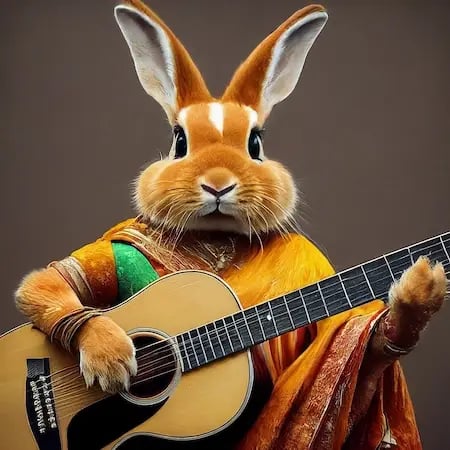
Then I asked for an electric guitar:
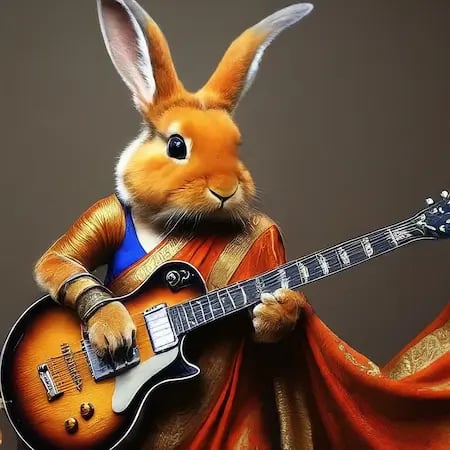
Why exactly? Well, as I’m sure many people justify their oddball AI creations: Because I could.
For the purpose of this article, I focused on a common marketing use case: creating an original image for a blog article.
I tested nine of the most popular AI image generators and evaluated them on their speed, ease of use, and image quality.
To fairly compare the options, I also eliminated variables by:
- Using the same prompt
- Requesting the same edit to the original prompt
I also ran each tool three times after each prompt, giving them a fair opportunity to deliver. Consider these my “trials.” This is science after all.
The prompt: “Generate an image of a young marketing executive presenting information on a television screen in front of a small group of teammates”
The edit: Generate a photo-realistic image of a young marketing executive presenting information on a television screen in front of a small group of teammates.
Let’s get started.
The Best AI Image Generators
1. Midjourney
Midjourney is considered one of the most powerful generative AI tools out there, so my expectations for its image generator were high. It focuses on creating artistic and stylized images and is popular for its high quality.
Pricing: $10-120 per month, depending on the plan.
Test Results:
I’m used to the chatbot setup of ChatGPT, so Midjourney wasn’t what I expected.
To create, you have to join the Midjourney Discord channel (similar to Slack). From there, you use keyboard commands within chats to have the Midjourney bot perform your desired tasks.
In this instance, I had to join a “newbie” chat (there were several to choose from) and enter the command “/imagine” followed by my prompt. Then, the Midjourney bot processed my request (and sometimes those of others simultaneously.)
It delivered four images with each trial.
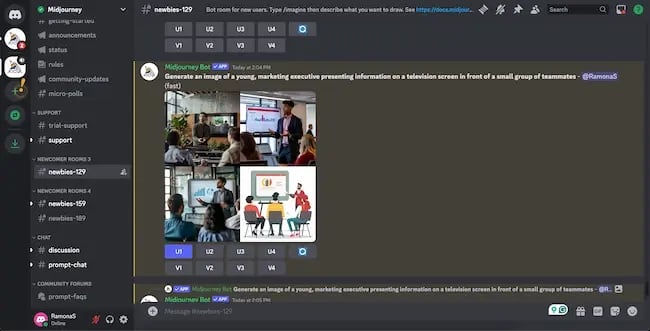
From there, I could click numbered buttons underneath the images to get “upscales” (U) or variations (V) of a particular image. It isn’t entirely clear to a “newbie” what an upscale or variation means.
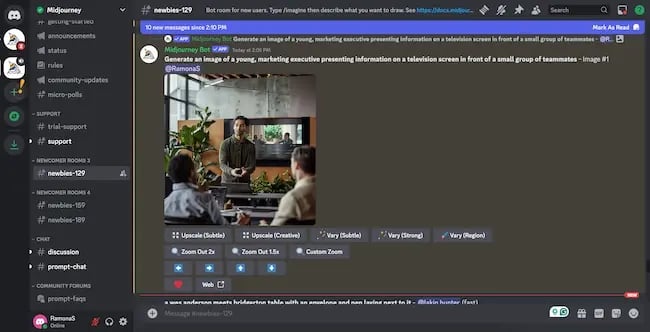
Personally, I wasn’t the biggest fan of this process. Anyone in the chat can see your prompt and results and even download them for their own use. Your results could also quickly be buried by others, and you’d have to scroll up to find them.
Speaking of results, they were quick but varied in quality.
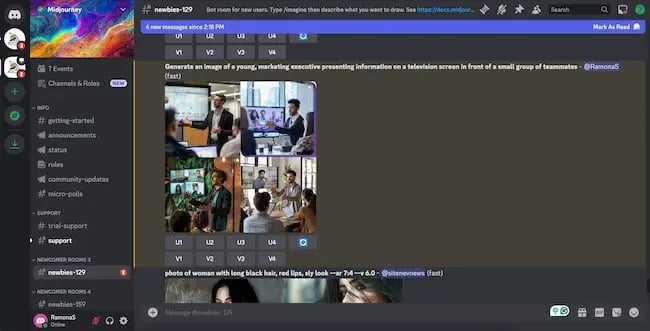
The AI delivered a variety of styles and included some diversity in its human subjects (no glaring issues with features), but it produced the same settings and poses in each option.
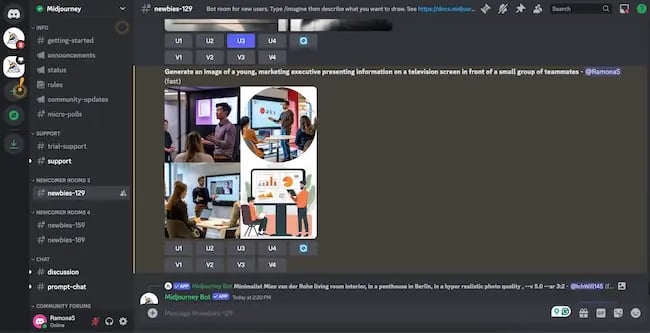
Also, there was no clear way to edit the images created. I tried responding to the bot to no avail.
My second prompt resulted in less photo-realistic images — even though I specified that’s what I wanted:
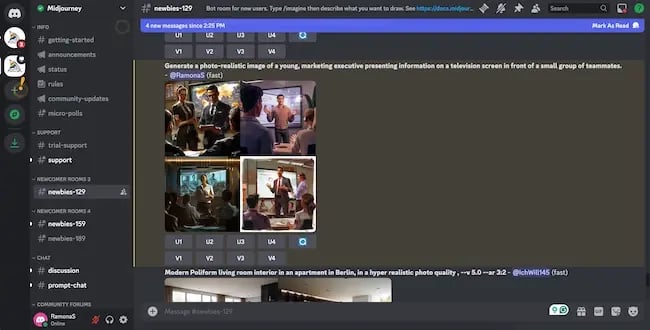

Overall, I have to say I was disappointed by Midjourney. Navigating was frustrating and didn’t produce the quality I expected from the hype.
Someone with more experience in Discord or prompting it might yield better results, but it didn’t win me over.
What I like:
- Fast (images in under 60 seconds)
- Multiple images at once
What can be improved:
- User-friendliness
- Privacy
- Editing capabilities
- Image style variety
- Photo-realistic quality
Best For: Artistic endeavors, marketers with advanced technical knowledge, web developers, or those comfortable within Discord who can learn to navigate the nuances of prompts.
2. DALL-E 3
Owned by OpenAI (the company behind ChatGPT), DALL-E is a pioneer in image generation.
DALL-E3, the latest iteration of the tech, is touted as highly advanced and is known for generating detailed depictions of text descriptions. This means users can create original images and modify existing ones based on text prompts.
Pricing: It is available to ChatGPT Plus, Team, and Enterprise users, as well as developers through the API, starting at $20 per month.
Test Results:
Unlike most tools on our list, DALL-E3 generated only one image at a time.
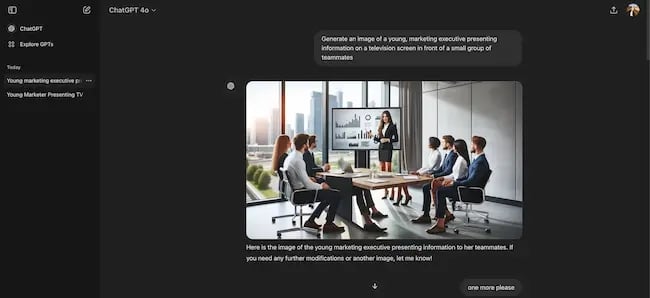
In a world where a search engine can find millions of pictures in seconds, this is highly limiting and, honestly, underwhelming. But the image quality was impressive.

It showed detailed, realistic portrayals of people and had no visible difficulty replicating fingers or eyes, as we often see with AI. It also allows users to edit specific image details:
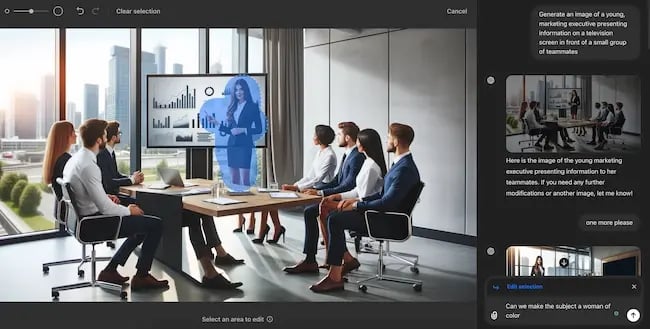
For example, I requested that the main subject of the image above shift to a woman of color and that the information on the television screen be changed to an Instagram profile.
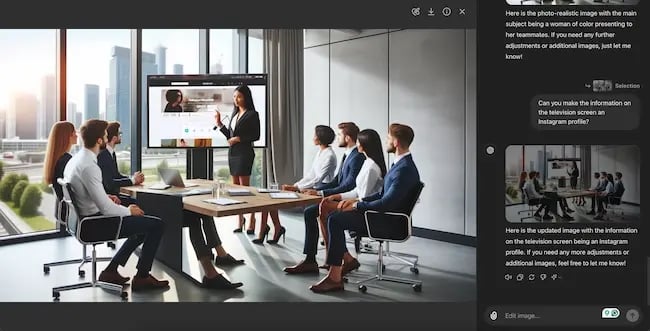
After editing, the photo wasn’t as seamless. You could see where the AI spliced in the new content and certainly did not use an Instagram profile, but I digress.
As you may be able to guess from my requested edit, where DALL-E3 fell short was its lack of diversity and variety.
After running two more trials with my initial prompt, the settings of the image stayed the same — a generic, corporate office, while main subject in all of the images looked very similar as well, and most noticeably, all White or European.
While the results for the initial prompt were quite photo-realistic, I ran my second prompt.
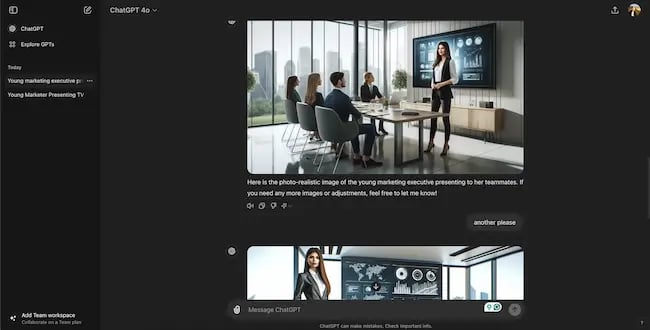
The results were consistent, and the diversity issue also remained. Out of curiosity, I ran one more test in a new chat window and found that all images were now of men, but again, they all appeared to be White or European.
I was able to request changes to make the people in the image more racially diverse, but it took several tries.
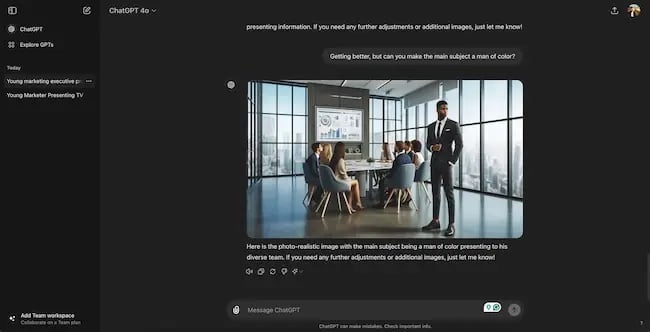
Stereotyping and bias are common concerns with AI image generators, and that may be an issue with DALL-E3.
What I like:
- High-quality images (crisp, detailed)
- Realistic human depictions
- Ability to edit image details
What could be better:
- Only one photo per prompt
- Lack of diversity without additional prompting
- Lack of variety in the setting
- Lack of control over specifications (dimensions, style, etc.)
Best For: Brands that would benefit from ChatGPT’s greater AI abilities. In my opinion, the cost is not worth it just for image generation, especially considering some of the amazing free options in this list.
Pro Tip: If you find yourself getting the same results with each regeneration, or requesting edits proves fruitless, try opening a new chat window.
3. Microsoft Designer
Designer is an AI image generator from Microsoft. It’s positioned as a tool to help you “create social media posts, invitations, digital postcards, graphics, and more, all in a flash.” Many say it’s a Canva competitor, and I can see why.
Designer uses DALL-E2 to generate images from text prompts, but you can also start with one of the built-in templates or tools.
Its user-friendly templates include stickers, collages, greeting cards, and social media posts. Users can also perform everyday editing tasks like removing a background from an image.
Pricing: Everyone gets 15 free generations per day, but this jumps to 100 with a Microsoft Copilot Pro membership for $20 per month.
Test Results:
Coming from DALL-E3, I was immediately pleased to see Designer deliver four images with each run of my test prompt. I was also happy to see the diversity in gender, race, and even setting.
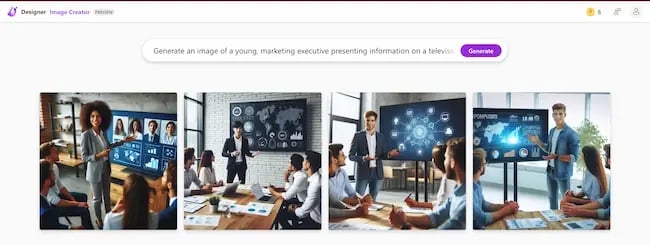
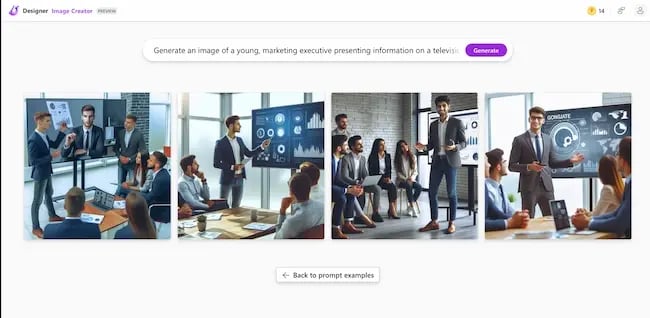
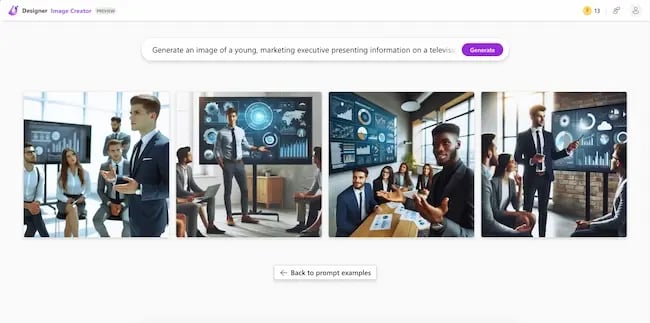
Like DALL-E3, the Designer results were realistic from the start (with no face or feature issues), but most still had an illustrative stroke.
Nevertheless, after running my second prompt, the results remained similar:
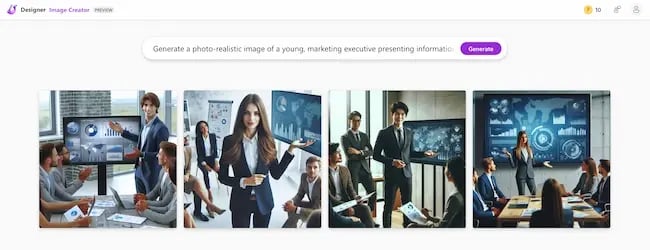
Once I found an image I liked, Microsoft Designer let me download, copy, edit, or use it in another design on the platform:
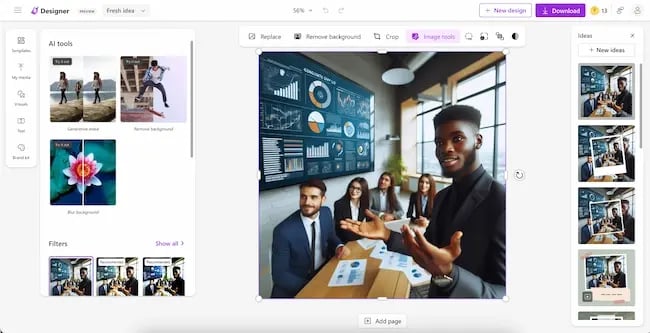
What I like:
- Multiple images at once
- High-quality images (crisp, detailed)
- Accurate depictions of people
- Lots of diversity (both in people featured and in style/setting of image)
What could be better:
- All images are square by default
- “Photo-realistic” images still have an illustrative look
Best For: Microsoft Designer is a great free option for almost anyone, but it’s especially valuable to teams looking for design flexibility or those heavily invested in social media. Microsoft Designer makes it easy to create graphics using its images.
4. Adobe Firefly
Firefly is design giant Adobe’s answer to generative AI. It can generate art or photo-style images in four common aspect ratios (square, portrait, landscape, and widescreen), and it allows users to select or upload resources for reference.
Pricing: Free for 25 credits per month, but premium plans offer more credits starting at $4.99 per month.
Test Results:
Honestly, Firefly immediately blew me away.
Not only was it the fastest tool, but it also delivered four images in various styles, with a diverse group of subjects and some of the most photo-realistic results I’ve seen.
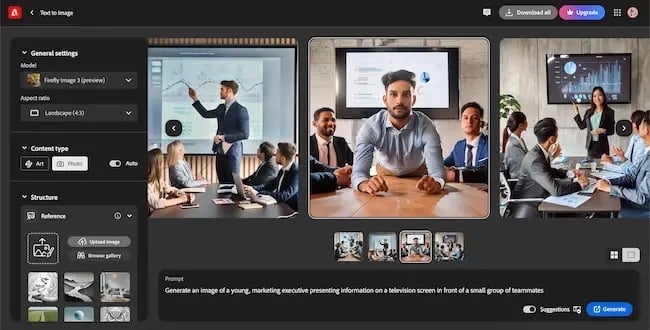
The depictions of humans were mostly realistic, but as I ran my additional trials, I did spot flaws like missing faces or choppy cut-outs in the backgrounds.
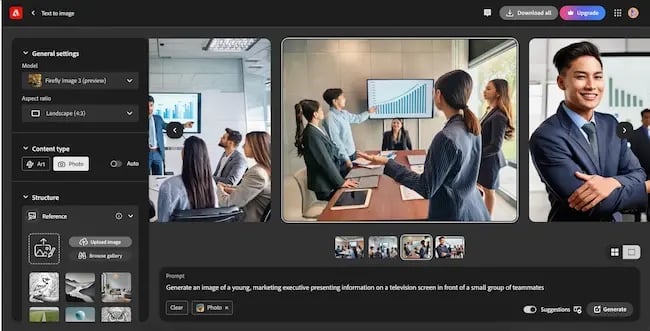
Since Designer has a built-in option for photos, I deviated a bit from my experiment. I ran the initial prompt under the art filter to evaluate the differences.
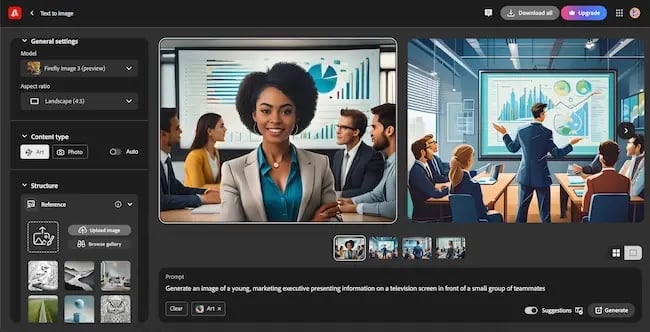
Again, they were striking. The results were a mix of vectors and illustrations that employed bold colors, precise details, and visual depth for beautiful results.
The platform also let me edit the images, generate more based on one I liked, and use any of the images in an Adobe Express design.
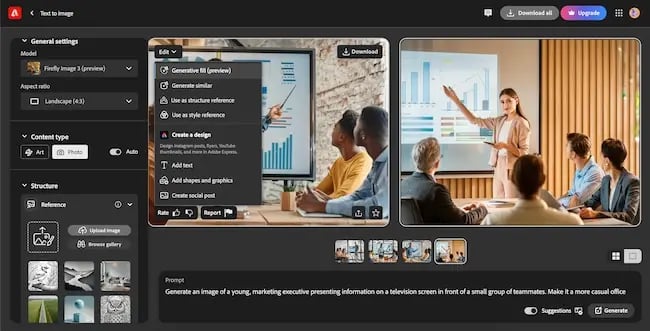
What I like:
- Free
- Fast
- Multiple images at once
- High-quality, photo-realistic images (crisp, detailed)
- Accurate depictions of people (mostly)
- Lots of diversity (both in people featured and in style/setting of image)
- Easy-to-use images in a design
- Edit specific details of images
What could be better:
- Have to inspect closely for flaws
- More image styles
Best For: Great option for anyone, especially as a free tool. Both the artistic and photo results are top-notch and easy to repurpose into design inside and outside of Adobe.
5. Canva Magic Design
Canva’s AI image generator, Magic Design, brings the power of AI to the masses. You can use it to generate images, graphics, or videos in square, vertical, or horizontal aspect ratios, and you can choose from over 20 visual styles.
Pricing: All users get 10 free Magic Designs over their lifetime, but if you want more, varying usage limits are available in Pro, non-profit, and Education accounts, starting at $120/year.
Test Results:
With the initial prompt, Canva delivered four graphic/illustrated images in each trial. Many figures were simple vectors without any defining features, reminiscent of 1990s clip art.
You can see the results of each trial circled in the same color.
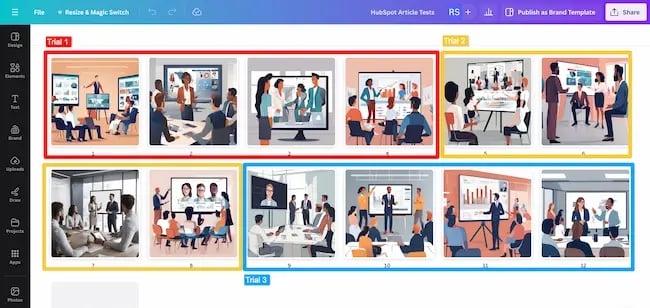
Upon entering my “photo-realistic” prompt, the results changed accordingly but left much to be desired.
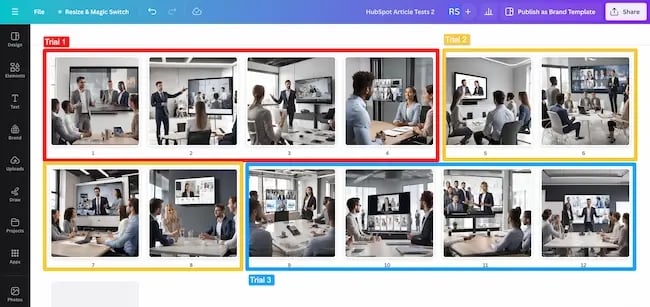
The AI appeared to struggle with recreating finer details like hands, fingers, eyes, and on-screen content.
Nevertheless, if you find an image you like, you can easily use it in a new design within the Canva platform.
What I Like:
- Fast
- Easy to use
- Lots of visual styles
- Offers video
What could be better:
- Photo-realistic results
- Depictions of people
- Attention to detail
Best for: Those already investing in Canva Pro. This can be useful for art, vectors, or social media designs.
6. Meta AI
Meta AI is a free intelligent assistant from the parent company of Facebook and Instagram. The company claims the chatbot is “capable of complex reasoning, following instructions, visualizing ideas, and solving nuanced problems,” including generating images.
Pricing: Meta AI is free for all Facebook users.
Test Results:
Meta AI is set up as a chatbot, and upon entering my test prompt, I was floored.
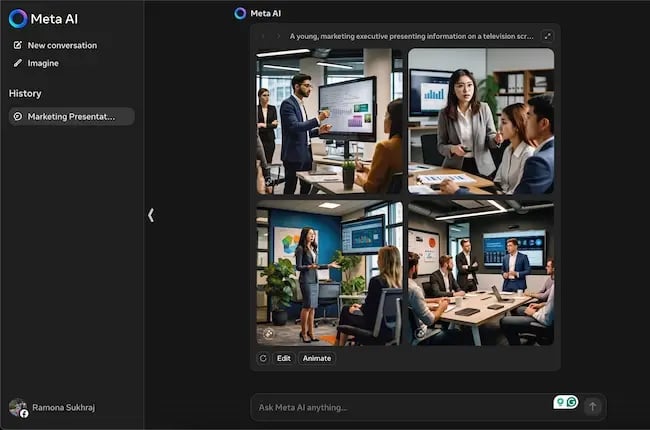
With each trial, Meta delivered four images — all vibrant, detailed, and in various settings. They also featured diverse groups of people.
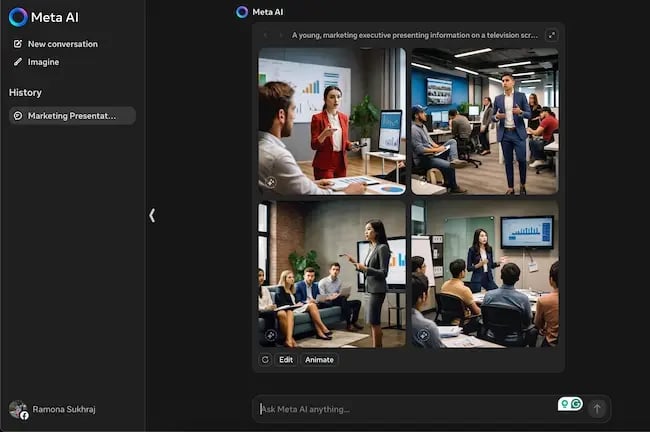
Looking closely at the faces, you can see some imperfections. But, for the most part, the images could easily be used in smaller sizes without any concern.
Meta AI also allows you to click into an image to request edits (though this will change the entire image, not just a part, like with DALL-E3).
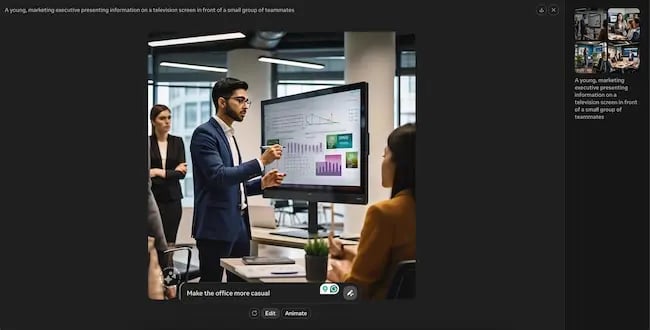
Or you can animate the images with the click of a button.
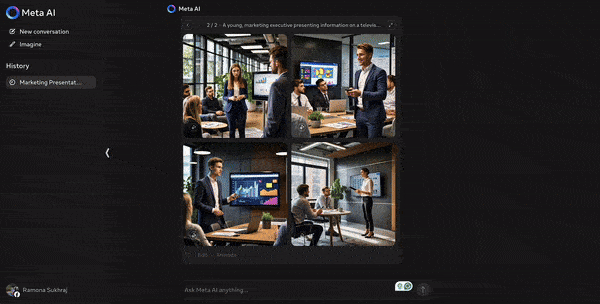
What I like:
- Free
- Fast
- Multiple images at once
- High-quality, photo-realistic images (crisp, detailed)
- Accurate depictions of people (mostly)
- Can animate results with the click of a button
- Lots of diversity (both in people featured and in style/setting of image)
What could be better:
- Specific edits
- Images are watermarked
Best for: Small digital graphics for social media, eBooks, or otherwise.
7. Gemini
Gemini, formerly Bard, was launched by Google in December 2023. Similar to competitor ChatGPT, Gemini responds to text prompts as a chatbot.
However, taking a page out of the Google search engine playbook, it can natively understand images, audio, video, and code. In other words, you can upload a video and ask Gemini to summarize it.
Pricing: It’s free, but “For Business” accounts are available with Google Workspace. Gemini Advanced is also available with a Google One AI Premium plan for $19.99 per month.
Test Results:
This test was short but not necessarily sweet.
After entering my test prompt, I was met with a message saying, “We are working to improve Gemini’s ability to generate images of people. We expect this feature to return soon and will notify you in release updates when it does.”
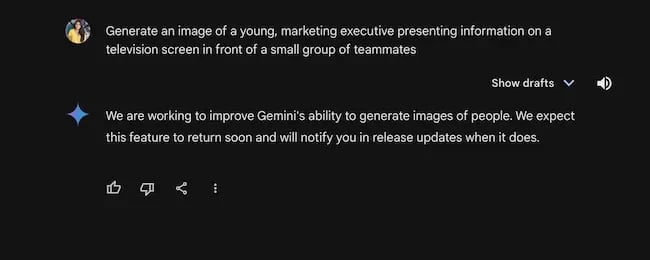
The ability to create images of people was removed in February 2024, noting that “some of the images generated are inaccurate or even offensive.”
Understandably, Google took precautions by turning off the feature but, of course, that makes Gemini unusable in our marketing use case.
Gemini can still create images (A la my orange rabbit from earlier), but the instances are specific and cannot include human beings.
What I like:
- Easy to use
- Free
- Images are high-quality
What could be better:
- On the slower end
- No depictions of people, not even animated
Best for: Creative, abstract, or illustrative images
8. Jasper Art
Jasper is a platform trusted by over 100,000 leading brands and agencies, including Wayfair, Ulta, and MorningStar.
Its AI image generator, Jasper Art (only available under Pro plans), promises users the perfect picture to match their messaging.
It offers high-resolution, 2,000-pixel images, royalty-free commercial use, and unlimited generations, all without a watermark.
Pricing: Jasper Art starts at $49 per month per seat or ($39 per month per seat with annual payment), but a 7-day free trial is available.
Test Results:
I learned you can start creating from scratch with “free form” or with a “template” which includes categories like food photography, ink art, news graphic, and storybook photography.
In “free form,” Jasper Art allows you to refine your creation with a mood (i.e., calm, gloomy, or whimsical), medium (i.e., collage or ink), style (i.e., pop art or art deco), keyword (i.e., black & white or close-up), or language.
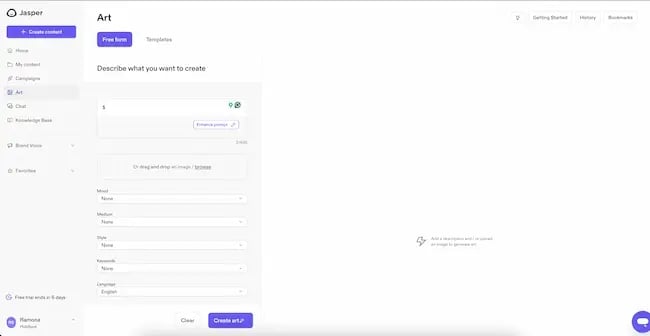
For this experiment, however, I stuck to “free form” and left all of the refinements empty.
Jasper delivered four images and took just a few seconds, but, to be honest, the results were lackluster.
The “young executives” all appeared older and were men with lighter skin tones. Few women were in the photos, and if there were, they were in the background. This was consistent throughout my trials, so, like DALL-E3, I had concerns about AI bias.
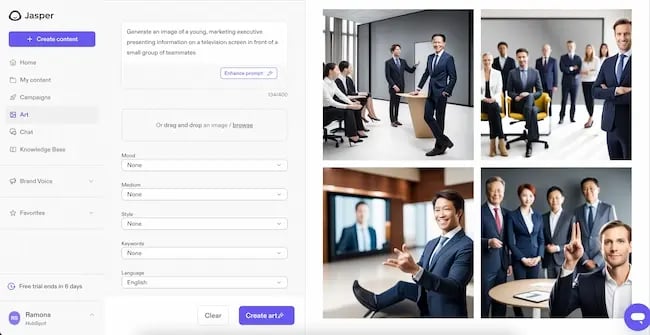
Furthermore, Jasper struggled with recreating features like hands and fingers. One image even appears to have an elf leg coming out of a man’s hip onto a table.
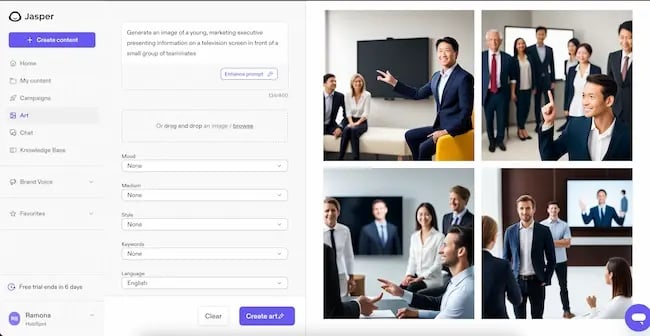
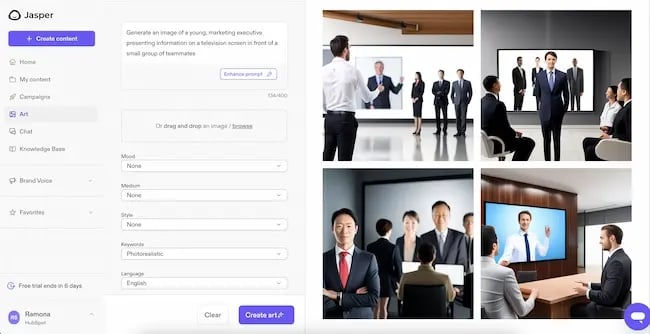
Like other tools, Jasper’s results were photo-realistic, but to confirm, I reran the prompt using the keyword filter “photorealistic.” The results were unchanged.
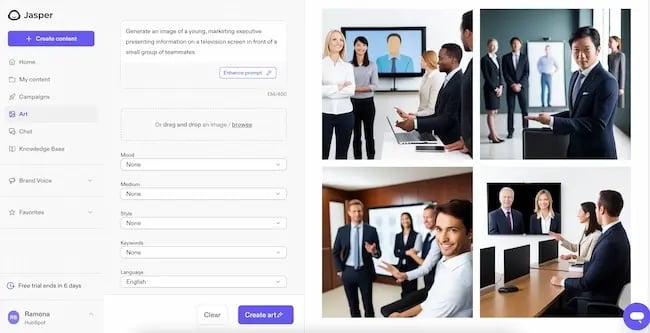
I also experimented with the styles (specifically pop art and acrylic paint) to see how the tool handled those.
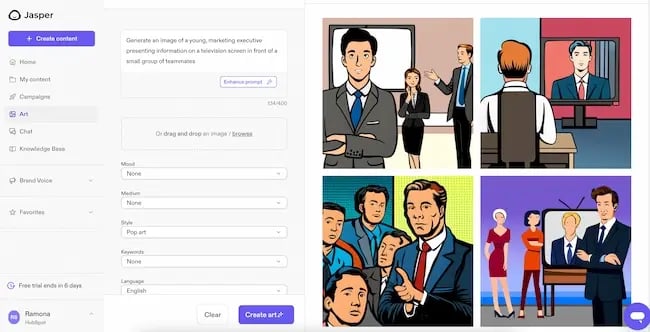
Pop art was true to its name, but Jasper appeared to have difficulty with acrylic paint, delivering images that looked half vector and half photo-realistic.
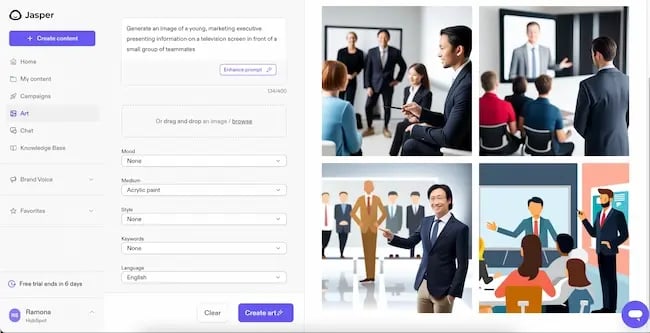
If you like an image, Jasper Art lets you download it in three different sizes, copy it to your clipboard, or share it to X (formerly Twitter), Facebook, or Reddit.
What I like:
- Easy-to-use
- Multiple images at once
- Offers templates
- Offers high-resolution downloads
What could be better:
- Difficulty recreating human features
- Lack of diversity
- Concerns of bias
Best For: Abstract or creative images. It’s worth playing around with, if you already pay for Jasper Pro, but wouldn’t pay just for Jasper Art.
Pro Tip: In “free form, ”Jasper AI offers to “enhance your prompt” with the click of a button. It expanded my prompt and passed the 400-character limit while allowing me to edit before generating my images. While I didn’t use this feature in the experiment, Jasper’s assumptions seemed to match the pictures it produced.
Reviewing the more detailed prompts may give you more insight into the image it will create by default.
9. Getimg.ai
While researching this article, I found Getimg.ai in a Reddit discussion. Redditors raved about it, so I had to see why. With a paid plan, it can generate photorealistic, artistic, or anime-style images, up to 10 at a time.
Pricing: Free for 100 credits per month, or paid plans beginning at $12/month which unlock more credits and features.
Test Results:
Getimg.ai generates four images by default on a free plan, and it can deliver up to 10 with a premium plan. It’s also transparent about its speed, displaying how long it takes to generate each image. The images I created took under 30 seconds.
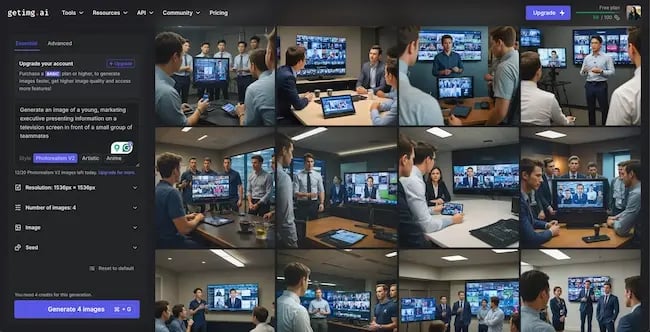
My immediate reaction: Zero diversity. Except for one or two subjects, everyone in the photos is a white man, and many of them look like they could be cousins, brothers, or even twins.
In other words, Getimg.ai seems to use the same face repeatedly in one image.
If this works for you, the tool lets you like, download, generate similar images, or use them in a design. With a paid plan, you can also convert the image into a video.
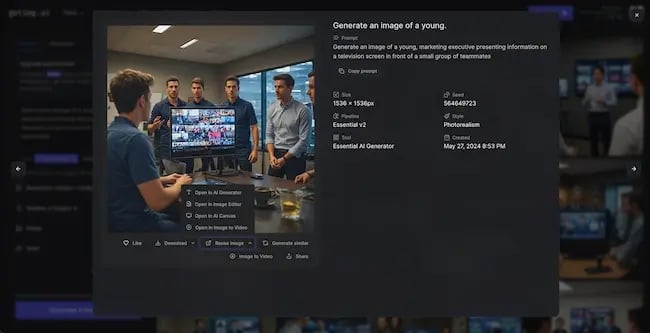
As the tool defaults to photorealistic, I once again deviated from my test edit to run the prompt in other built-in styles.
“Anime” delivers some beautiful creative images that are very much in line with what you’d expect from the Japanese style. In contrast, “Artistic” is reminiscent of characters in a video game. I personally expected them to look more like paintings or illustrations.
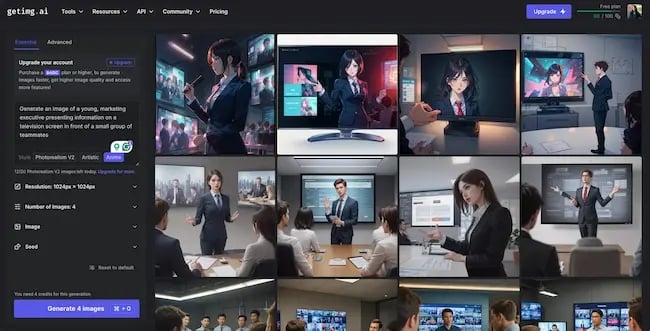
What I like:
- Generous free plan
- Easy to use
- Fast (and transparent about generation speed)
- Multiple images at once
- Can upload reference images and tell it what not to generate with a “negative prompt”
- Multiple aspect ratio options
What could be better:
- Diversity (in demographics as well as the setting of the photo)
Best For: Creative or artistic images. Brands or marketers targeting younger audiences interested in Anime
Put the best to the test!
What you consider the best AI for creating images is subjective. In my opinion, many of the free tools have more to offer marketers than the paid ones.
I was particularly impressed by Adobe Firefly. It delivers some of the most realistic photos and professional-looking artistic images on the list, and it allows you to edit specific details.
For a marketer who is likely using an AI image generator to create an original image for content or a digital graphic, it more than gets the job done at no cost. On top of its creative prowess, it’s hard to top.
![]()
If Hubspot is of interest and you'd like more information, please do make contact or take a look in more detail here.
Credit: Original article published here.
